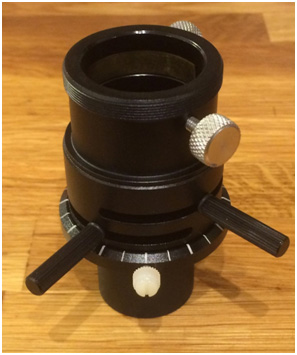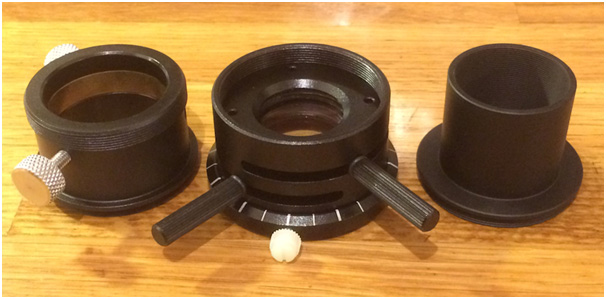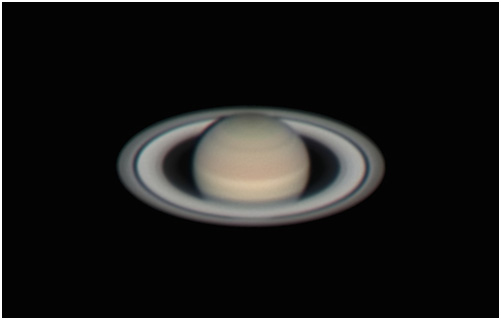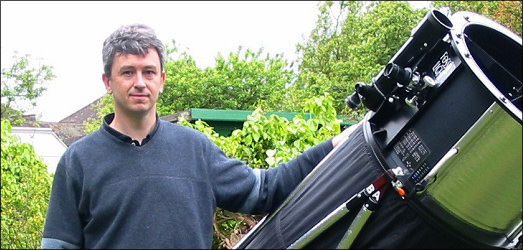ZWO Atmospheric Dispersion Corrector - Product Review
By: Martin LewisDiscuss this article in the forums
September 13, 2016In this product review, Martin Lewis of SkyInspector.co.uk takes a look at the ZWO Atmospheric Dispersion Corrector (ADC). This compact device was designed to enable improved imaging of planets, especially planets at low altitude, by reducing the color smearing induced by atmospheric dispersion.The ZWO atmospheric dispersion corrector is the most affordable ADC on the market, but how well does it perform? Read Martin's review to find out.1. Overview
The ability to produce good quality high-resolution planetary images is hampered by atmospheric dispersion, an effect in which white light is separated vertically into a spectrum of colors, with blue at the top and red at the bottom. The atmosphere effectively acts like a weak prism, causing light entering at an angle to be bent by refraction to a slightly steeper angle. Because refraction is wavelength dependent, an effect known as dispersion, the apparent 'lift' that the object gets from atmospheric refraction varies according to the color of the light (see figure 1 below). Atmospheric dispersion gets more pronounced when the altitude of the object is lower. That's bad news for those in the Northern hemisphere because the brightest planets Jupiter, Saturn, and Mars will be at low elevations during their oppositions for the next several years through 2020 and beyond.
 Figure 1: Atmospheric dispersion causes white light to be separated into its component colours with blue at the top and red at the bottom.
Figure 1: Atmospheric dispersion causes white light to be separated into its component colours with blue at the top and red at the bottom.You can align the separate red, green and blue images manually or automatically during processing to remove the worst effects of atmospheric dispersion. But you can't use this method to correct any dispersion occurring within the color band itself. Dispersion within the color band is worse for shorter wavelengths like blue, worsens with decreasing altitude, and is much more problematic for one-shot color (OSC) cameras. That's because these cameras have much wider color bands than monochrome cameras which are usually used with dedicated high-quality R,G, and B filters.
To help planetary imagers and visual observers combat atmospheric dispersion, adjustable devices called Atmospheric Dispersion Correctors (ADCs) have become commercially available in recent years. These devices contain a pair of thin circular prisms which act to nullify the dispersion caused by the passage of light through the atmosphere by introducing dispersion of the opposite direction.
ADCs can give considerable benefits in image quality when planets are less than 30° high, but they also help improve detail when the planet is as high as 60°. An ADC can help with RGB mono imaging, one-shot color imaging, true luminance imaging, and even during visual use (You can learn more about the operation of atmospheric dispersion correctors at this link)
ADCs operate best at higher focal ratios (>f/20), and this generally means they should be placed between the Barlow lens and the camera. Adjustment of an ADC involves setting the mid-point of the prism's horizontal and then moving the two prism control levers apart by equal amounts until the colour fringing from the atmosphere is cancelled out. Again, the link above gives more information on how to actually do this.
2. Atmospheric Dispersion Correctors for Amateur Planetary Imagers
Prior to the launch of the new ZWO ADC at the end of 2015, three commercial ADCs were available on the market. By far the most expensive was made by Gutenhurst Optics. It is really targeted at professional users and it costs several thousand dollars. Unlike other commercial ADCs, this device has prisms each made of a crown and flint pair to eliminate the image positional shift that unfortunately usually goes hand in hand with the corrective dispersion.
Lower cost ADCs, priced for the amateur market, have been available for a number of years from ASH (Astro Systems Holland, http://www.astrosystems.nl) and from Pierro Astro in France (http://www.pierro-astro.com). Both devices cost around $500. Although much less expensive than the Gutenhurst ADC, this pricing is high enough to remain a major barrier to wider adoption by amateur planetary imagers.
The ZWO ADC is a much lower-cost device. It's available for about $130 in North America, and it promises to open up the benefits of ADCs to a much greater number of imagers. But how does such a low-cost device perform compared to its competitors? To answer this, I assessed an early production model of the ZWO ADC bought at the end of 2015.
3. Operation of the ZWO Atmospheric Dispersion Corrector
As seen in figure 2 below, the device's mechanical build quality looked very good. Although not quite on par with the more expensive Pierro Astro model, it is nicely machined with an attractive black-stove enamel finish.
 Figure 2: The ZWO Atmospheric Dispersion Corrector (ADC).
Figure 2: The ZWO Atmospheric Dispersion Corrector (ADC).Like the PA and ASH ADCs, the ZWO device is modular with three parts (see figure 3 below): a removable 1.25" to T-thread nosepiece, the main body, and a T-thread to 1.25" compression ring adaptor (with T-threaded top) to fit your eyepiece or camera. This design means that you can use the 1.25" nosepiece to fit the device into your imaging chain or, if you prefer, you can use the more stable T-thread connections. However, if you connect with a T-thread, then you need to have a way of rotating the ADC body to line things up.
 Figure 3: The three parts of the ZWO ADC (L to R)- Eyepiece holder, ADC body with levers, 1.25" nosepiece.
Figure 3: The three parts of the ZWO ADC (L to R)- Eyepiece holder, ADC body with levers, 1.25" nosepiece.The ZWO device and the ASH device share one unusual aspect. Both the input and the output side of the ADC is female threaded. A more conventional approach has female threads on the input side and male threads on the output side. In the case of the ZWO unit, this was done to match with the male-to-1.25" adaptor that ZWO already sells and which has a male bottom end and becomes the top end of the device to plug your camera or eyepiece into.
To adjust the degree of corrective dispersion of an ADC, you rotate the two prisms in opposite directions using long levers that run in two slots. Like the Pierro model, these slots overlap considerably, giving the choice to move the levers together over a wide range to compensate for changing scope orientation without requiring you to rotate the body of the ADC. This might require an adjustment of focus. A feature unique to the ZWO ADC is a central white 'zero' marker screw which makes it easier to initially align the body of the ADC with the horizontal direction while working in the dark. Normally this is aligned with the horizontal and is the mid-position of the two levers. The levers are threaded with a rubber O-ring at the bottom where it meets the body. Twisting the knurled levers locks the rotation. With this design you can unlock the prisms and adjust the moving resistance for just the right feel. Again, like the PA and ASH ADC, the ZWO device has marker divisions on the outside of the body so you can set the levers equally on either side of null position and also so you can easily set the ADC to the same amount of compensational adjustment on different nights. The scale is in 15° intervals, and I liked the bevelled design of the graduated ring because the scale is easily visible from both the side and from the rear.
When setting up the ADC it is important that the levers are on the correct side of the body. Rotating the whole device 180° but still having the white knob aligned with the horizontal will actually made the atmospheric dispersion worse, not better! There are reports of some ZWO ADCs where the prisms are mounted 180° out, turning a 'righty' into a 'lefty'. This won't affect the operation, but it is something to be aware of.
4. Performance of the ZWO Atmospheric Dispersion Corrector
I tested my model of the ZWO ADC on Saturn, which was low in the south, using a ZWO ASI224MC one shot color (OSC) digital video camera and a 444mm (17.5") Newtonian telescope. With Saturn at an altitude of only 17°, I found considerable benefits from the ZWO ADC over the conventional method of aligning colour channels in post processing. This is shown in figure 4 below and shows how the vertical smearing is essentially eliminated.
 Figure 4: The benefits of using the ZWO ADC.
Figure 4: The benefits of using the ZWO ADC.The main image from this night of reasonable seeing is shown figure 5 below. It has lots of detail including a glimpse of the planet's disc through the Cassini division. It's amazing to think that it used to be considered pointless to image planets much below an altitude of 30°, and it shows what a massive advantage there is in using the ZWO ADC in these conditions.
 Figure 5: Saturn as imaged with a ZWO ASI224MC camera and ZWO ADC at maximum correction.
Figure 5: Saturn as imaged with a ZWO ASI224MC camera and ZWO ADC at maximum correction.As well as testing on imaging planets at low altitude, I managed to carry out a star test inside and outside of focus on Polaris at an altitude of 52°. In this test, with the prisms set to minimise dispersion, I could detect no astigmatism induced by the prism pairing and got nice symmetrical out of focus images. The prisms in the device have a 2° deviation angle and are said to be made of H-K9L glass (equivalent to Schott BK7) polished to 1/10-wave accuracy. Although coated BK7 isn't optimised for UV work, I was able to test the transmission of the ADC on Venus with a Baader Venus filter (300 to 400nm transmission peaking at 360nm). The transmission of the device was about 80% of a Pierro Astro ADC with UV optimised optics, but despite some light loss it was still quite usable. The ZWO website gives a transmission plot from 350nm to 660nm, but I'm not sure if this is a general plot for BK7 or is measured on a device itself.
The cleanliness of the prisms in the supplied unit was my solitary gripe, and I had to do some careful targeted cleaning with a swab and cleaning solvent to remedy this.
Overall the ADC from ZWO represents great value for money. It is very affordable and it works well in compensating for the effects of atmospheric dispersion when imaging planets. Those serious about getting the best planetary images have no excuse for not adding one to their kit and getting real benefits from it.
 About the Author
About the Author
Martin Lewis is a U.K.-based planetary imager, telescope builder, and sketcher of deep sky objects. He lives about 35km north of London on the east side of the city of St Albans and observes from his back garden with his home-built 444 mm Newtonian reflector. In his day job, he is a principal engineer for Scintacor, a company that makes scintillation sensors for X-ray detection for medical and dental applications. He is an active member of the West of London Astronomical Society (WOLAS).
***
This article is © AstronomyConnect 2016. All rights reserved. Images © Martin Lewis 2016.
Please login or register to watch, comment, or like this article.
-
Final Announcement: We're Saying Goodbye to AstronomyConnect. Read Our Closing Notice.
Dismiss Notice
New Cookie Policy
On May 24, 2018, we published revised versions of our Terms and Rules and Cookie Policy. Your use of AstronomyConnect.com’s services is subject to these revised terms.

